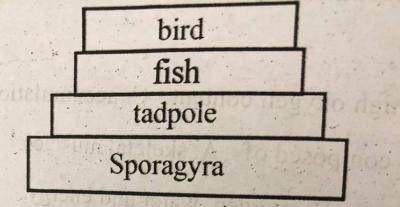Year :
2019
Title :
Biology
Exam :
WASSCE/WAEC MAY/JUNE
Paper 1 | Objectives
31 - 40 of 50 Questions
| # | Question | Ans |
|---|---|---|
| 31. |
The complex relationship between the members of a community and their physical environment is known as________ A. commensalism B. symbiosis C. saprophytism D. ecology |
D |
| 32. |
The specific role of a species within íts environment is known as its_________ A. habitat B. niche C. trophic level D. biotic community |
B |
| 33. |
Which of the following soil fertility improvement methods will have the most negative effect on the ecosystem if not controlled? A. Application of N-P-K fertilizer B. Shifting cultivation C. Mixed farming D. Crop rotation |
A |
| 34. |
Organisms in an ecosystem are usually grouped according to their trophic level into__________ A. carnivores and omnívores, B. consumers and parasites C. producers, and saprophytes D. Producers and consumers |
D |
| 35. |
 In the pyramid of energy illustrated above, the organism with the least amount of transferred energy is___________ A. Spirogyra B. Tadpole C. Fish D. Bird |
D |
| 36. |
Tall trees with unbranched trunks which grow above the upper storey of the forest are commonly referred to as _____ A. Emergents B. Herbs C. Lianes D. Shrubs |
A |
| 37. |
Maize grains are best stored against insect attacks by__________________ A. keeping in a silo B. storing in the room C. leaving them on their cobs D. covering with leaves |
A |
| 38. |
Cholera is mostly spread by_______ A. air B. soil C. water D. noise |
C |
| 39. |
Which of the following resources is renewable? A. Petroleum B. Coal C. Iron D. Trees |
D |
| 40. |
Which of the following roles is not performed by a government agency responsible for forest maintenance? A. Regulating the harvest of timber and poaching B. Creating, protecting and managing the forest reserves C. Tracking the movement of timber, wood, and wildlife D. Regulating mining activities in the forest |
D |
| 31. |
The complex relationship between the members of a community and their physical environment is known as________ A. commensalism B. symbiosis C. saprophytism D. ecology |
D |
| 32. |
The specific role of a species within íts environment is known as its_________ A. habitat B. niche C. trophic level D. biotic community |
B |
| 33. |
Which of the following soil fertility improvement methods will have the most negative effect on the ecosystem if not controlled? A. Application of N-P-K fertilizer B. Shifting cultivation C. Mixed farming D. Crop rotation |
A |
| 34. |
Organisms in an ecosystem are usually grouped according to their trophic level into__________ A. carnivores and omnívores, B. consumers and parasites C. producers, and saprophytes D. Producers and consumers |
D |
| 35. |
 In the pyramid of energy illustrated above, the organism with the least amount of transferred energy is___________ A. Spirogyra B. Tadpole C. Fish D. Bird |
D |
| 36. |
Tall trees with unbranched trunks which grow above the upper storey of the forest are commonly referred to as _____ A. Emergents B. Herbs C. Lianes D. Shrubs |
A |
| 37. |
Maize grains are best stored against insect attacks by__________________ A. keeping in a silo B. storing in the room C. leaving them on their cobs D. covering with leaves |
A |
| 38. |
Cholera is mostly spread by_______ A. air B. soil C. water D. noise |
C |
| 39. |
Which of the following resources is renewable? A. Petroleum B. Coal C. Iron D. Trees |
D |
| 40. |
Which of the following roles is not performed by a government agency responsible for forest maintenance? A. Regulating the harvest of timber and poaching B. Creating, protecting and managing the forest reserves C. Tracking the movement of timber, wood, and wildlife D. Regulating mining activities in the forest |
D |